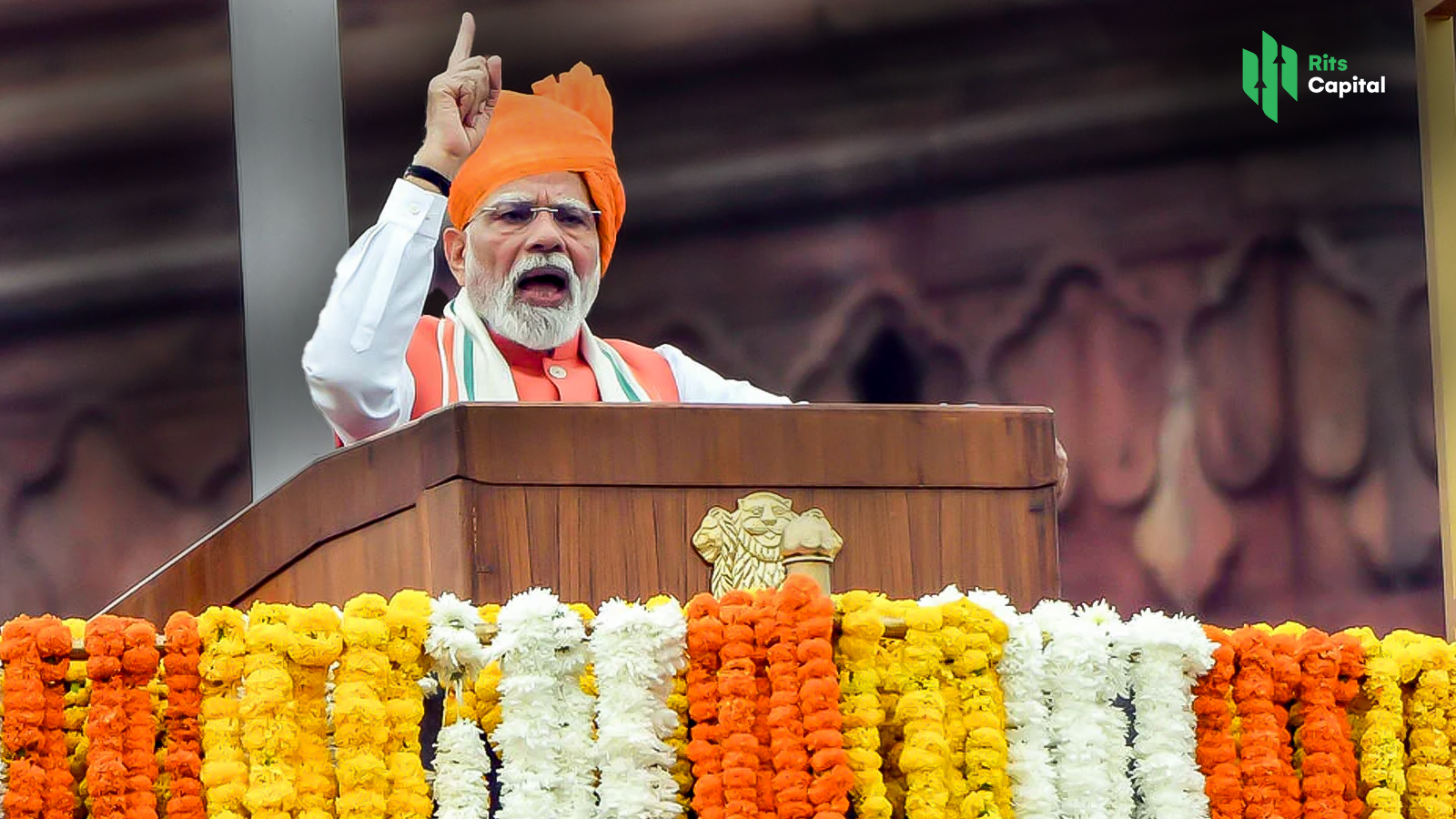On the occasion of India’s 79th Independence Day, Prime Minister Narendra acknowledge the nation towards Bharat@2047—a developed, self-reliant, and globally competitive country. The speech lasted over 100 minutes, the address focused on growth, self-reliance, technology, and youth empowerment, with the Prime Minister unveiling 10 major announcements that will going to help to shape India’s future. Modi’s Independence Day speech highlighted a vision that blends tradition with innovation, and ambition with execution.
10 Key highlights from Modi’s Independence Day Speech
Here are the 10 key highlights that from speech for Vision and growth towards Bharat @2047:
- Defence Doctrine: Retaliate on Our Terms: A new assertive doctrine allows India to respond to threats according to its own timing and strategy-strengthening national security resolve.
- . Indus Treaty: Blood and Water Won’t Flow Together: Clear Stance- India’s water and sovereignty are non-negotiable, sending a strong message on cross-border relations.
- Operation Sindoor: Deep Strikes, Zero Tolerance of Terror: The Government is setting up offensive actions against terror networks, highlighting its commitment to national security and proactive defence.
- Farmers First: Pro-Agri Policy Assurance: PM Modi pledged no anti-farmer, anti-fisheries, or anti-diaries policies, safeguarding rural livelihoods and food sectors.
- Made in India: Fighter Jet Engines: The Push for indigenous jet engines signals India’s ambition for aerospace self-reliance, empowering domestic manufacturing of defence.
- GST 2.0 by Diwali: Simpler, cheaper: A second wave of GST Reforms is promised by Diwali, expected to lower tax rates and reduce compliance, benefiting MSMEs and consumers alike.
- Atmanirbhar Defence Push: India will deepen its self-reliance in defence, from research to manufacturing, giving a fillip to local industry and cutting import dependence.
- ‘Samudra Manthan’ Oil & Gas Mission: A Multi-pronged exploration drive aims to unlock domestic energy resources, pursuing energy independence and investment in renewables.
- 1 Crore Jobs-Rozgar Yojana: The PM Viksit Bharat Rozgar Yojana aims to create 1 Crore jobs, expanding opportunities for India’s youth and boosting the economy.
- Ratings Upgrades = Global Trusts: Improvement in India’s international ratings underscores rising global confidence in its economic, fiscal, and governance standards.
Sectoral optimization: Which Sectors Will Benefit Most?
Defence and Aerospace
Policies such as Atmanirbhar Defence and the call for Made-in-India fighter jet engines will drive optimization in manufacturing, R&D, and engineering.
Companies in defence equipment, aircraft component manufacturing, and precision engineering stand to benefit from higher contracts and government support.
Energy and Natural Resources
The Launch of the “Samudra Manthan” Oil & Gas Mission and push for energy independence recognizes energy as a vital sector for optimization.
Enhanced exploration of oil, gas, and renewables (Solar, Hydrogen, and renewables) will stimulate investment in extraction technologies, infrastructure, and supply chain.
Agriculture & Allied Industries
Whether through policy stability or farmer-friendly schemes, this sector should see robust policy-driven optimization in logistics, production, and direct benefit to producers.
MSME, Retail & Consumer Sectors
GST 2.0 Direct target compliance reduction and lower rates, optimizing the MSME, retail, auto, and FMCG sectors for easier operations and increased demand.
Employment and Human Capital
The 1 Crore jobs push through Rozgar Yojana will optimize the employment sector, channelling skilled youth into industries with high growth potential.
Strategic Infrastructure & Governance
Rating upgrades and reforms pledge improved governance, fiscal responsibility, and infrastructure expansion-optimising India’s investment climate and ease of doing business.
Conclusions
Defence energy and MSME sectors emerge as the top beneficiaries of optimization from Modi’s Independence Day speech, backed by robust policy initiatives, fiscal initiatives, and an ambitious national mission. Agriculture, employment, and strategic infrastructure also gain momentum, setting the stage for rapid, inclusive, and innovative sectoral growth in India’s next chapter.
For Grabbing these emerging trends! Partner with Rits Capital today to seize early opportunities and become a early investors in innovative sectors.
Read also: BOAT Unlisted Shares: A Pre-IPO Opportunity in India’s Consumer Tech Boom
FAQ’s:
1. What was the central theme of PM Modi’s Independence Day speech?
Ans: The Prime Minister outlined a bold roadmap to make India a developed nation by 2047, focusing on national security, self-reliance, job creation, and economic reforms.
2. Which sectors are expected to benefit the most from these announcements?
Ans: Defence and aerospace, energy and natural resources, MSMEs, agriculture, and infrastructure are the top gainers, with policy support and investment opportunities.
3. What is GST 2.0 and why is it important?
Ans: GST 2.0, to be launched by Diwali, promises simpler compliance, reduced tax rates, and lower costs—especially benefiting MSMEs, retailers, and consumers.
4. How will the government create new jobs?
Ans: Through the PM Viksit Bharat Rozgar Yojana, the government aims to generate 1 crore jobs, channeling India’s youth into fast-growing industries.
5. What impact will the Atmanirbhar Defence push have?
Ans: The push for indigenous defence manufacturing, including fighter jet engines, will cut import reliance, boost local R&D, and strengthen India’s security ecosystem.

